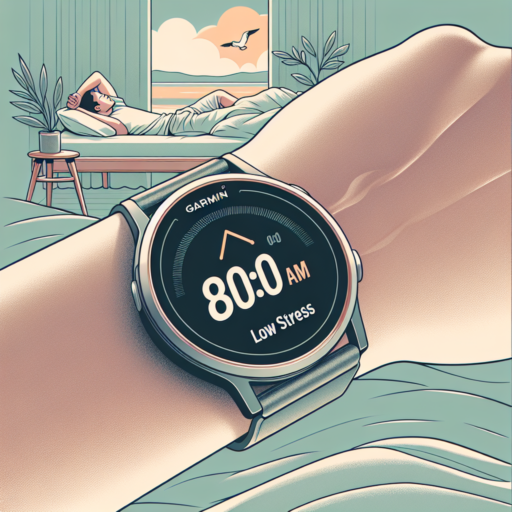Understanding Garmin Watch Stress Level Feature
The Garmin Watch Stress Level Feature is a sophisticated tool designed to help users monitor and manage their stress on a day-to-day basis. By utilizing advanced heart rate variability (HRV) data, Garmin watches can provide a comprehensive stress score that ranges from 0 to 100, offering a clear and intuitive understanding of the wearer’s current stress levels. This unique measure allows individuals to take proactive steps in stress management, reinforcing the essential link between physical well-being and stress reduction.
Garmin’s approach to calculating stress levels involves analyzing the varying time intervals between each heartbeat. These fluctuations, known as HRV, are a reliable indicator of how your body responds to stress. A higher HRV suggests a relaxed state, while a lower HRV indicates stress or fatigue. By continuously tracking these variations, Garmin watches offer an instant snapshot of your stress landscape, enabling timely interventions like breathing exercises, mindfulness, or physical activity to alleviate stress.
It’s not just about understanding when you are stressed; the Garmin Stress Level Feature also aims to encourage better lifestyle habits. Through its Garmin Connect app, users can access detailed stress analyses, trends over time, and personalized insights. This fosters greater awareness about what could be triggering stress in one’s life, guiding users towards more balanced and healthier living. Whether it’s identifying specific activities that calm you or recognizing patterns that may lead to stress, Garmin provides the tools necessary for effective stress management.
How Does Your Garmin Watch Calculate Stress Level?
Understanding how your Garmin watch calculates stress level begins by exploring the technology and mechanisms it utilizes. At the core of this functionality is the watch’s heart rate variability (HRV) monitoring capability. HRV refers to the variation in the time interval between consecutive heartbeats. Your Garmin watch leverages this data to assess your stress level, as fluctuations in HRV are directly linked to the body’s stress response.
In addition to HRV, Garmin watches also consider various other factors such as physical activity and sleep patterns. For instance, continuous physical activity or a lack of restful sleep can elevate stress levels. By analyzing your daily activities and sleep quality, the watch can provide a more comprehensive stress profile.
The algorithm behind the stress level calculation is designed to offer insights into your overall well-being. However, it’s important to note that while Garmin watches can provide valuable data about your stress levels, they should not replace professional medical advice. Always consult with a healthcare provider for a thorough stress assessment and management strategies.
Maximizing Your Stress Management with Garmin Watch
In the fast-paced world we live in, managing stress effectively has become crucial for maintaining overall health and well-being. Garmin watches have emerged as a technological ally in this battle against stress, offering features that help monitor and mitigate stress levels actively. Understanding how to leverage these sophisticated tools can profoundly enhance your daily life, turning stress management from a daunting task into a streamlined routine.
Tracking Stress Levels
Garmin watches come equipped with comprehensive stress tracking capabilities. This feature uses heart rate variability (HRV) data to assess your stress levels throughout the day. By monitoring slight variations in your heartbeats, the watch provides an accurate picture of how stressed you might be at any given moment. What’s more, Garmin watches offer real-time stress tracking, which means you can see how your stress level changes in response to different situations and activities, enabling you to pinpoint stress triggers and avoid them when possible.
Guided Breathing Exercises
Another standout feature for stress management is the guided breathing exercises available on Garmin watches. These exercises are designed to help you relax and reduce stress through slow, controlled breathing. By following the on-screen instructions and adjusting your breathing pattern accordingly, you can achieve a state of calmness much needed in stressful situations. This biofeedback approach not only helps in immediate stress relief but also contributes to long-term stress management techniques, making it a valuable tool in your wellness arsenal.
The integration of these features in a Garmin watch exemplifies how wearable technology can serve as a cornerstone in managing day-to-day stress. By staying informed about your stress levels and utilizing built-in relaxation techniques, you can take significant strides in enhancing your mental and emotional health. Engagement with these features enables users to embark on a journey towards a more balanced and less stressful lifestyle, proving that with the right tools, managing stress is an achievable goal.
Exploring the Accuracy of Garmin Watch Stress Measurements
Garmin watches have emerged as a popular tool for monitoring various wellness metrics, among which the stress level measurement feature stands out. Garnering attention from both fitness enthusiasts and individuals concerned with their mental health, understanding how accurately Garmin watches quantify stress levels has become a focal point for many users. This section delves into the dynamic method utilized by Garmin devices to quantify stress, paving the way for a broader conversation on its accuracy.
At the heart of Garmin’s stress measurement lies the analysis of heart rate variability (HRV). This biometric data, stemming from the minute variations in time intervals between heartbeats, serves as a critical indicator of the body’s autonomic nervous system activity, particularly relating to stress and relaxation. Garmin employs this data, integrating it with proprietary algorithms to present a user-readable index of stress levels. It’s paramount to consider the inherent complexities in interpreting HRV data, as it can be influenced by a myriad of factors beyond stress, from physical activity to sleep patterns.
The accuracy of Garmin watch stress measurements, while highly regarded, is not without its skeptics. Users and experts alike ponder on the precision of these readings, especially when contextual factors are at play. Evaluating Garmin’s technology against clinical standards reveals a fascinating juxtaposition of high-tech wearables against established medical equipment used in psychological stress assessments. Such evaluations highlight the strengths and limitations of relying on Garmin watches for accurate stress measurements, leading to an informed dialogue among users about the practical use of this feature in their daily lives.
Top Garmin Watches with the Best Stress Level Tracking
When seeking the ideal Garmin watch for stress level tracking, it’s crucial to consider the technology and features that make certain models stand out. Garmin has been at the forefront of incorporating wellness monitoring in its devices, offering users a comprehensive view of their health, including how they handle stress. The importance of stress management in today’s fast-paced world cannot be overstated, and having a reliable tool on your wrist can make a significant difference.
Gamin’s innovative approach to stress monitoring involves continuous heart rate tracking combined with variability data to assess how your body responds to various stressors throughout the day. This allows users not only to see their stress levels but also to understand patterns and triggers, making Garmin watches invaluable for anyone looking to improve their mental and physical well-being.
Among the vast array of Garmin watches, certain models excel in stress tracking features. These include the Garmin Venu 2, Fenix 6 Series, and the Forerunner 745. Each of these watches provides detailed insights into your stress levels, offering not just raw data but also tips and exercises to help reduce stress. The Garmin Venu 2, with its bright AMOLED display, offers not only stress tracking but also mindfulness breathing activities, making it an excellent choice for those looking to maintain calmness. The Fenix 6 Series is designed for the rugged adventurer who wants to keep track of their body’s stress response in different environments. Lastly, the Forerunner 745 is tailored for athletes looking to optimize their training by understanding how stress impacts their recovery and performance.
Understanding your stress levels is a pivotal step towards achieving a balanced lifestyle. With Garmin’s sophisticated technology, individuals have access to precise metrics that help manage stress, improve resilience, and enhance overall well-being. By choosing a Garmin watch equipped with the best stress level tracking, you’re investing in a healthier future.
Tips for Reducing Your Stress Level Using Garmin Watch Insights
Managing stress is an integral part of maintaining a healthy lifestyle. Garmin watches, known for their sophisticated health tracking features, offer valuable insights into your stress levels, helping you manage your day-to-day tension effectively. Understanding how to leverage these insights can be a game-changer in your quest for well-being.
Monitor Your Stress Patterns
Begin by regularly checking your Garmin watch’s stress tracking feature. It uses heart rate variability (HRV) to estimate your levels of stress throughout the day. By identifying patterns or specific times when your stress levels peak, you can pinpoint factors that contribute to your tension. Recognizing these triggers is the first step toward managing them, whether it’s through delegating tasks, avoiding certain triggers, or allocating time for relaxation and decompression. Regular monitoring allows for a proactive approach in stress management.
Utilize Relaxation Reminders
Garmin watches not only track stress but also offer tools to help manage it. One of the most effective is the relaxation reminder. Set your device to alert you when you’ve been in a high-stress state for an extended period. This prompt can serve as a crucial nudge to take a break, breathe deeply, or engage in a short meditation session. Incorporating brief relaxation exercises into your day, especially during identified high-stress periods, can significantly lower your overall stress levels and improve your mental health.
Review and Reflect on Stress Trends
Lastly, leveraging the data collected by your Garmin watch over time can offer profound insights into your stress management journey. By reviewing trends, you can assess the efficacy of changes you’ve made to your lifestyle or routines. Have certain adjustments led to a decrease in stress? Or are there new stressors you’ve not yet addressed? Continuous reflection is crucial for long-term stress reduction. Acknowledge the victories, no matter how small, and understand that managing stress is an ongoing process that requires patience and perseverance.
Comparing Garmin Watch Stress Level Feature with Other Brands
When exploring the landscape of modern wearable technology, one can’t overlook the innovative stress-level monitoring feature that has become a staple for health-conscious users. Among them, the Garmin Watch stands out for its advanced approach to stress tracking, but how does it fare against competitors? In this comparison, we delve into the nuances that differentiate Garmin’s implementation of this vital health metric from other leading brands.
Garmin watches utilize a complex algorithm that measures heart rate variability (HRV) to assess stress levels, providing users with a detailed view of their physiological stress throughout the day. This data is presented in an easy-to-understand format, offering insights into periods of high, medium, and low stress, coupled with recovery times. The question arises, however, when we consider how other brands like Fitbit and Apple Watch approach stress tracking. Both have introduced their own versions of stress monitoring, using similar HRV metrics but integrating them differently into their ecosystem.
For instance, the Fitbit system places a significant emphasis on guided breathing sessions as part of its stress management strategy, aiming to offer immediate relief. Similarly, the Apple Watch integrates stress level data with its Mindfulness app, encouraging users to engage in mindfulness exercises. Such integrations show the varying philosophies between brands: Garmin focuses on comprehensive monitoring and data presentation, while others prioritize immediate user engagement and intervention.
Moreover, it’s crucial to consider the accuracy of these technologies. Garmin’s stress level feature is renowned for its precision, thanks to the brand’s long history in developing sports and wellness technologies. This experience translates into more nuanced and potentially more accurate stress level readings compared to those offered by other brands, which might prioritize broader health metrics. As the discourse around wellness and technology continues to evolve, the race to provide the most insightful and actionable stress tracking solutions is undoubtedly heating up, with Garmin leading in certain aspects but facing stiff competition from other innovative players in the wearable tech space.
Comprehensive Guide to Interpreting Your Garmin Watch Stress Data
Understanding the stress data from your Garmin watch can seem daunting at first, but it’s a powerful tool for managing your health and wellbeing. Garmin devices use Heart Rate Variability (HRV) to estimate your levels of stress throughout the day, offering a window into how your body responds to pressures and relaxation. Interpreting this data effectively can help you make informed decisions about stress management and overall lifestyle improvements.
Decoding the Stress Levels
Your Garmin watch categorizes stress into different levels ranging from ‘resting’ to ‘high stress.’ Low stress levels suggest that your body is in a relaxed state, ideal for recovery and rest. Moderate stress indicates normal daily stress, which may come from both physical and emotional sources. When your device shows high stress levels, it’s a sign that your body is experiencing intense pressure, which, if prolonged, could affect your health. Recognizing these levels can guide you to take proactive steps in managing your stress.
Understanding the Role of Heart Rate Variability (HRV)
At the heart of Garmin’s stress tracking is HRV, which measures the time difference between each heartbeat. A higher HRV indicates more variability between beats, typically a sign of low stress and a relaxed body state. Conversely, a lower HRV suggests less variability and higher stress levels. By monitoring changes in your HRV, you can identify patterns and potential triggers in your daily life that contribute to stress, allowing for a more tailored approach to stress management.
No se han encontrado productos.
Improving Mental Health: Stress Level Tracking with Your Garmin Watch
Unlocking the Potential of Your Garmin Watch for Better Mental Health
Your Garmin watch is more than just a fitness tracker; it’s a powerful tool for monitoring and improving your mental health. Recognizing the correlation between stress levels and overall mental well-being, Garmin has equipped its watches with advanced technology designed to track stress, offering insights that can help you navigate your day more mindfully. This functionality enables users to see patterns in their stress levels, potentially leading to healthier lifestyle choices and coping mechanisms.
How Stress Tracking Works on Your Garmin Watch
The mechanism behind stress tracking on your Garmin watch involves constant monitoring of your heart rate variability (HRV). HRV measures the variation in time between each heartbeat, which is directly linked to your body’s stress response. A higher HRV suggests a relaxed state, whereas a lower HRV indicates stress. By analyzing this data, your Garmin device provides you with a stress score ranging from 0 to 100, where lower scores mean less stress. This immediate feedback allows for acute management and long-term stress reduction strategies, empowering you to make real-time adjustments to your daily routine.
Strategies for Reducing Stress with Your Garmin Watch
Beyond just tracking, your Garmin watch offers proactive suggestions to help lower your stress. This includes guided breathing exercises, reminding you to take a moment for yourself when stress levels spike. Moreover, analyzing your stress patterns over time can identify specific triggers, leading to a more targeted approach in managing stress. Whether it’s reallocating time for relaxation, adjusting your physical activity, or enhancing sleep quality, your Garmin watches’ stress tracking feature acts as a roadmap for personal mental health improvement.
FAQs: Common Questions About Garmin Watch Stress Level Tracking
Garmin watches are renowned for their advanced health tracking features, and among these, the ability to monitor stress levels has attracted considerable attention. Users often have several questions regarding how this feature works, its benefits, and how to interpret the stress level data provided by their Garmin watch. Below, we delve into some common queries to shed light on this innovative functionality.
How Does the Garmin Watch Track Stress Levels?
Stress tracking in Garmin watches employs heart rate variability (HRV) data to gauge your stress levels throughout the day. HRV refers to the variation in time intervals between consecutive heartbeats, which can be an indicator of your body’s autonomic nervous system activity. Garmin’s algorithms analyze these variations to classify your stress level on a scale, providing insights into your physical and emotional well-being.
What Can I Learn from My Garmin Watch’s Stress Level Data?
Interpreting the stress level data from your Garmin watch can be highly informative for managing overall health. By observing patterns and fluctuations in stress levels, users can identify potential stressors in their daily life and make informed decisions to avoid or mitigate these situations. Furthermore, the data can serve as a motivational tool for engaging in stress-reducing activities such as meditation, yoga, or regular exercise, helping enhance not just mental, but also physical health.
Understanding the intricacies of Garmin watch stress level tracking can empower users to take proactive steps towards maintaining a balanced lifestyle. By paying close attention to the stress level data provided by their Garmin device, individuals can make adjustments to their daily routines, potentially leading to reduced stress levels and improved overall well-being.




